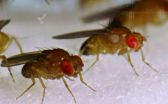(Press-News.org) Researchers at the University of Kent and East Malling Research have identified a new way of controlling a fungal disease that can have a devastating impact on the UK's valuable cherry and plum crops.
Brown rot disease – caused by the agent Monilinia laxa – attacks stone fruit as well as causing blossom wilt and twig canker. Traditionally, this has been controlled through the use of fungicide treatments, but in some cases these are now becoming ineffective.
Now researchers from the two organisations have identified a new strategy for controlling the disease, using biological control agents derived from isolates from UK cherries and plums.
The researchers identified 12 possible isolates and then narrowed this down to two via a series of tests on detached fruit. Controlled sets of cherries and plums – with and without the biological control agents added - were placed in conditions known to induce the onset of brown rot disease.
Professor Peter Jeffries, of the University's School of Biosciences, said: 'Brown rot disease is a major problem for the UK's cherry and plum producers and in a growing number of cases traditional fungicide treatments are becoming ineffective.
'Our research found that microbial antagonists against the brown rot disease can be found from indigenous sources in the UK and that they are capable of preventing the disease in controlled conditions.
'The challenge now will be to see whether these biocontrol agents can be adapted commercially and be used by the stone fruit industry to control brown rot disease.'
Currently, East Malling Research is exploiting ways with commercial companies to formulate the two strains of biocontrol agents and conduct pilot commercial trialling of formulated products.
INFORMATION:
The study was carried out by Professor Jeffries and research student Nattawut Rungjindamai of the School of Biosciences, along with Professor Xiang-Ming Xu of East Malling Research. The Department for Environment, Food and Rural Affairs, together with several commercial organisations, funded the research as part of a Hort-LINK project (HL01105): Developing biocontrol methods and their integration in sustainable pest and disease management in blackcurrant production.
The research paper, titled Identification and Characterisation of New Microbial Antagonists for Biocontrol of Monilinia laxa, the Causal Agent of Brown Rot on Stone Fruit, is published in the journal Agronomy.
Researchers identify new way to control stone fruit disease
2014-02-18
ELSE PRESS RELEASES FROM THIS DATE:
In search of lost genes
2014-02-18
How do new genes arise? Current research shows that so-called "orphan genes" may appear as if by magic as a result of mutations in segments of DNA that previously had no function. Orphan genes were first discovered in the fruit fly but are found in all organisms, including man. Strikingly, up to 30 per cent of the total number of genes in an organism may be orphans and these genes may rapidly acquire functions. Scientists from the Institute of Population Genetics of the University of Veterinary Medicine, Vienna (Vetmeduni) have now investigated the fate of orphan genes. ...
HIV drug used to reverse effects of virus that causes cervical cancer
2014-02-18
A commonly-used HIV drug has been shown to kill-off the human papilloma virus (HPV) that leads to cervical cancer in a world-first clinical trial led by The University of Manchester with Kenyatta National Hospital (KNH) in Nairobi.
Drs Ian and Lynne Hampson, from the University's Institute of Cancer Sciences and Dr Innocent Orora Maranga, Consultant in Obstetrics and Gynaecology at KNH in Nairobi examined Kenyan women diagnosed with HPV positive early stage cervical cancer who were treated with the antiviral HIV drug lopinavir in Kenya.
The study looked at 40 women ...
Leeds researchers build world's most powerful terahertz laser chip
2014-02-18
A paper in the Institution of Engineering and Technology's (IET) journal Electronics Letters reports that the Leeds team has exceeded a 1 Watt output power from a quantum cascade terahertz laser.
The new record more than doubles landmarks set by the Massachusetts Institute of Technology (MIT) and subsequently by a team from Vienna last year.
Terahertz waves, which lie in the part of the electromagnetic spectrum between infrared and microwaves, can penetrate materials that block visible light and have a wide range of possible uses including chemical analysis, security ...
The conditions for a society to become a democracy are analyzed
2014-02-18
This news release is available in Spanish. In view of the changes that have taken place in Europe,JuleGoikoetxea, a lecturer at the UPV/EHU's Faculty of Social Sciences and Communication, has been conducting research into "the conditions needed for a people to become a democracy or sustain its democratisation process over time."The study has been published in the specialised journal Nationalities Papers.
According to Goikoetxea, nation is not synonymous with demos: "The nation is the will, socially and historically articulated, that a group has in order to be a political ...
Researchers shed new light on the genetic history of the European beaver
2014-02-18
An international team of scientists has used detailed analysis of ancient and modern DNA to show that the distribution and lack of genetic diversity among modern European beavers is due largely to human hunting.
The research, which was led by University of York researcher Professor Michi Hofreiter, provides important new insights into the genetic history of the Eurasian beaver Castor fiber. Crucially, it shows the European beaver has been strongly affected by expanding human populations for many thousands of years.
The researchers say that centuries of hunting, rather ...
Surprising survey: Most small businesses remain silent rather than report employee theft
2014-02-18
In a recent survey of small businesses, a University of Cincinnati criminal justice researcher has found that only 16 percent of those that have experienced theft by employees actually reported that theft to the police.
That's even though 64 percent of the small businesses surveyed reported experiencing employee theft.
These are some of the findings in a survey of small businesses that examined the incidence of employee theft, how often it was reported, the types of goods taken by employees, the types of employees most likely to commit theft, and the reasons the business ...
Einstein's conversion from a static to an expanding universe
2014-02-18
Until 1931, physicist Albert Einstein believed that the universe was static. An urban legend attributes this change of perspective to when American astronomer Edwin Hubble showed Einstein his observations of redshift in the light emitted by far away nebulae—today known as galaxies. But the reality is more complex. The change in Einstein's viewpoint, in fact, resulted from a tortuous thought process. Now, in an article published in EPJ H, Harry Nussbaumer from the Institute of Astronomy at ETH Zurich, Switzerland, explains how Einstein changed his mind following many encounters ...
Daily walk of just 3km can reduce risk of hospitalization for respiratory problems
2014-02-18
New research in Respirology shows that suffers of Chronic obstructive pulmonary disease (COPD) can reduce their risk of being hospitalized with severe attacks, by maintaining an exercise regime of walking between three to six kilometers a day.
COPD, a term which includes chronic bronchitis and emphysema, results in breathing difficulties due to long-term lung damage. Severe symptoms (eCOPD), caused by a sudden loss of lung function, can be life threatening.
543 COPD patients were recruited from five Spanish respiratory clinics and their exercise levels were calculated ...
Magnesium may protect against hip fractures
2014-02-18
Drinking water with a relatively high concentration of magnesium protects against hip fractures, according to results of a study from the Norwegian Institute of Public Health.
There are considerable variations in the quality of drinking water in Norway. The researchers studied variations in magnesium and calcium levels in drinking water between different areas, as these are assumed to have a role in the development of bone strength. They wanted to examine whether there was a correlation between magnesium and calcium concentrations in drinking water and the incidence ...
Beauty & bacteria: Slim, attractive men have less nasal bacteria than heavy men
2014-02-18
Do attractive traits tell us anything about a person's reproductive health? New research in the American Journal of Human Biology reveals a link between Body Mass Index (BMI) and the amount of bacteria colonizing noses. The results show that heavier men harbor more potentially pathogenic species of bacteria in their nose, compared with slimmer, more traditionally attractive men.
"According to an evolutionary point of view, traits related to attractiveness are supposed to be honest signals of biological quality," said Dr. Boguslaw Pawlowski. "We analyzed whether nasal ...



